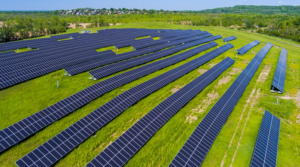
This week, an announcement was made by solar developers, environmental groups, farming associations, and tribal organizations regarding a newly reached agreement that may create a way forward for expanding solar farms.
This understanding could potentially help solve grievances about land use and biodiversity and streamline the process of constructing large-scale solar farms in the United States, an endeavor that has previously faced significant resistance.
The Solar Farm Land Use Issue
There’s been considerable resistance to large-scale solar initiatives from various factions, contending that these projects encroach upon tribal sacred lands or habitats of endangered flora and fauna. Additionally, some individuals have voiced opposition to solar farms on aesthetic grounds, asserting that they mar the scenic beauty or the rural character of their communities.
Installing more rooftop solar panels, which are typically less controversial, could contribute to fulfilling a portion of the electricity needs. However, a study conducted in 2021 by the National Renewable Energy Laboratory suggests that solar panels installed on residential and commercial buildings can only cater for a maximum of 20% of the total demand.
The remaining energy requirements would necessitate larger-scale projects occupying more significant land areas. According to some calculations, the volume of solar panels required solely in the United States might occupy a space equivalent to the combined land area of Massachusetts and Connecticut.
A Historic Agreement
Several days ago, the Solar Energy Industries Association and Nature Conservancy announced a historic agreement to advance solar power development.
Nearly two years back, Dan Reicher, with the Stanford University’s Woods Institute for the Environment, observed a growing resistance trend towards solar projects.
This opposition manifested in numerous heated public debates and legal actions, leading to substantial delays or outright cancellations of proposed solar initiatives. Reicher proposed an innovative solution, the Solar Uncommon Dialogue, to address this issue. He introduced this concept to The Nature Conservancy and the Solar Energy Industries Association (SEIA), the latter being the premier trade association for the solar industry in the United States.
On the 12th of October, 2023, an unprecedented accord was declared by the Solar Energy Industries Association (SEIA). This agreement brought together key players from various sectors, including leading solar developers, conservation organizations, agricultural groups, environmental and environmental justice advocates, as well as tribal entities including:
- American Farmland Trust
- Appalachian Voices
- Association of Fish and Wildlife Agencies
- Climate Adaptive Infrastructure
- EDP Renewables
- Intersect Power
- Invenergy
- Land Trust Alliance
- Lightsource BP
- National Audubon Society
- National Wildlife Refuge Association
- Natural Resources Defense Council
- North American Indian Center of Boston
- Pine Gate Renewables
- Solar Energy Industries Association
- The Lyme Timber Company
- The Nature Conservancy
- Theodore Roosevelt Conservation Partnership
- Union of Concerned Scientists
- WE ACT for Environmental Justice
The Solution
The accord is set to bolster large-scale solar development in the US while simultaneously championing land preservation and upholding the interests of local communities. This represents a significant milestone in resolving disputes surrounding the establishment of major solar projects in the US, as well as associated conservation and community apprehensions.
In the upcoming decade, a five-fold surge is anticipated in US solar energy production, aiding the fight against climate change and delivering clean, affordable energy to more communities. The swift expansion in utility-scale solar signifies that the industry must tackle a range of challenges, including the conversion of agricultural land, impacts on wildlife and their habitats, and effective community engagement.






